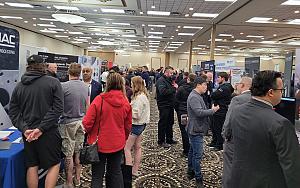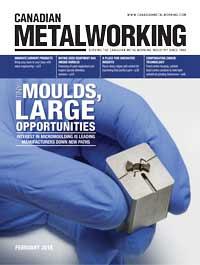- FMA
- The Fabricator
- FABTECH
- Canadian Metalworking
Technology Spotlight: Robot vision system
- March 1, 2018
- Article
- Automation and Software

Automating the bin picking operation keeps staff from having to do these repetitive jobs. Photo courtesy of Bluewrist.
Manufacturers have been using robots to pick and place parts for many years. These repetitive actions are, in fact, one of the tasks that is best suited for a robot to perform.
A task that robots traditionally have had difficulty with, however, is picking parts from bins, especially if those parts have been randomly placed. Two types of robotic bin picking technology are structured and random.
Structured parts typically are stacked in the bin in a very organized manner, making them easy to be “seen” by the vision system and picked by the robot. Random bin picking is more difficult because there is no organization or predictability to the part’s location or orientation.
This is a situation for more advanced robotics.
To automate the bin picking process, the robot must adapt to the random orientation of parts. Some systems use 2-D cameras, usually for structured picking, while others use 3-D cameras to determine the part’s location and orientation in the bin, then the robot performs its picking task based on the pictures it receives.
While these systems are becoming more capable and flexible than ever, robotic bin picking still has its limitations, namely with difficult-to-hold parts, small parts, and nearly empty bins.
Random Orientation Requires Specialized Systems
The goal of most vision system developers is random bin picking, and because of recent advances in vision technology, software, and end-of-arm tooling (EOAT), random bin picking is becoming a reality.
“There are a lot of new developments in robotics technology that are making implementation of random bin picking more common,” explained Jason Niu, Bluewrist marketing and communications manager.
Bluewrist, Markham, Ont., develops industrial automation systems that combine robots and machine vision systems for industrial applications.
The company’s FlexiPick is an advanced bin picking system that enables a robot to pick up parts even if they are randomly placed in a bin. It combines integrated software and hardware, an industrial robot, a 3-D vision sensor, EOAT, and a computer.
“Random bin picking requires that all of the technology in the system work together,” said Niu. “The cameras are the eyes of the system, the software is the brain, and the hardware the body, and all three must work in unison to perform the task. If one of the components fails, the whole system will fail.”
The ability to capture, analyze, and use part imagery allows the FlexiPick system to compare the part as it sits in 3-D space, orient the robot based on that data, and pick the part.
“There are huge improvements happening in the way we capture 3-D imagery and use that imagery to reduce picking time,” said Niu. “Our system actually compares the 3-D point clouds captured by the camera to the part model, and quickly returns all possible gripping configurations. This is what gives the system the ability to pick parts in virtually any orientation.”
So what makes robotic random bin picking difficult? It’s all about repeatability versus randomness.
“Robots are known for their repeatability, but the random nature of unstructured parts makes repeatability more difficult,” said Niu.
Vision technology is a critical component for most robotic applications. Bluewrist uses 3-D matching algorithms to build the point cloud of the bin, enabling it to select a part for picking, while avoiding collision with the bin walls and with other parts.
It’s the balance between robotic flexibility, vision, software, and computing power, all taking place in real time to extract parts from a bin as quickly as possible, that creates benefits in a manufacturing environment.
Benefits for robotic bin picking are:
- Improved part flow.
- Less time spent in downstream stacking.
- Manufacturing flexibility.
- Reduce manual labour costs.
- Higher throughput.
“Automating the bin picking operation keeps staff from having to do these repetitive jobs,” said Niu. “It also reduces the cost associated with sorting parts further downstream.”
Molded, forged, stamped, and machined parts can be picked using this technology. Both simple and complex parts that are tubular, spherical, and flat can all be picked.
FlexiPick also can be used for machine tending and other robotic cell tasks.
Editor Joe Thompson can be reached at jthompson@canadianmetalworking.com.
Bluewrist, www.bluewrist.com
subscribe now


Keep up to date with the latest news, events, and technology for all things metal from our pair of monthly magazines written specifically for Canadian manufacturers!
Start Your Free Subscription- Industry Events
ZEISS Quality Innovation Days 2024
- April 15 - 19, 2024
Tube 2024
- April 15 - 19, 2024
- Düsseldorf, Germany
Lincoln Electric's Large Format 3D Metal Printing Seminar
- April 16 - 17, 2024
- Cleveland, OH
CTMA Economic Uncertainty: Helping You Navigate Windsor Seminar
- April 30, 2024
- Windsor, ON Canada
MME Winnipeg
- April 30, 2024
- Winnipeg, ON Canada




















